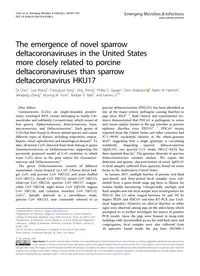
2018 The emergence of novel sparrow deltacoronaviruses in the United States more closely related to porcine deltacoronav PDF
Preview 2018 The emergence of novel sparrow deltacoronaviruses in the United States more closely related to porcine deltacoronav
Chen et al. Emerging Microbes & Infections (2018) 7:105 Emerging Microbes & Infections DOI 10.1038/s41426-018-0108-z www.nature.com/emi C O R R E S P O N D E N C E O p e n A c c e s s The emergence of novel sparrow deltacoronaviruses in the United States more closely related to porcine deltacoronaviruses than sparrow deltacoronavirus HKU17 Qi Chen1, Leyi Wang2, Chenghuai Yang1, Ying Zheng1, Phillip C. Gauger1, Tavis Anderson 3, Karen M. Harmon1, Jianqiang Zhang1, Kyoung-Jin Yoon1, Rodger G. Main1 and Ganwu Li1,4 Dear Editor, Coronaviruses (CoVs) are single-stranded, positive- sense, enveloped RNA viruses belonging to family Cor- onaviridae and subfamily Coronavirinae, which consist of four genera: Alphacoronavirus, Betacoronavirus, Gam- macoronavirus, and Deltacoronavirus1. Each genus of CoVs has been found in diverse animal species and causes different types of disease, including respiratory, enteric, hepatic, renal, reproductive and neurological diseases2. To date, all known CoVs detected from birds belong to genus Gammacoronavirus or Deltacoronavirus, supporting the previously proposed model of CoV evolution in which avian CoVs serve as the gene source for Gammacor- onavirus and Deltacoronavirus3. The genus Deltacoronavirus consists of different mammalian (Asian leopard cat CoV, Chinese ferret bad- ger CoV, and porcine CoV HKU15) and avian (bulbul CoV HKU11, thrush CoV HKU12, munia CoV HKU13, white-eye CoV HKU16, sparrow CoV HKU17, magpie- robin CoV HKU18, night heron CoV HKU19, wigeon CoV HKU20, and common moorhen CoV HKU21) CoVs3. Initially detected in a surveillance study, porcine CoV HKU15, now commonly referred to as porcine deltacoronavirus (PDCoV), has been identified as one of the major enteric pathogens causing diarrhea in pigs since 20144, 5. Both clinical and experimental evi- dence demonstrated that PDCoV is pathogenic to swine and causes similar lesions in the pig intestine as porcine epidemic diarrhea virus (PEDV)6, 7. PDCoV strains reported from the United States and other countries had 97.1–99.9% nucleotide identity at the whole-genome level8, suggesting that a single genotype is circulating worldwide. Regarding sparrow deltacoronavirus (SpDCoV), one sparrow CoV strain, HKU17-6124, has been reported thus far3. The genomic diversity of sparrow deltacoronaviruses remains unclear. We report the detection and genetic characterization of novel SpDCoV in fecal samples collected from sparrows found on swine farms in the midwestern United States. In January 2017, multiple batches of porcine oral fluid (pen-based) and floor-picked fecal samples were sub- mitted from a grow-finish stage pig farm in Illinois for routine health monitoring. Unexpectedly, multiple oral fluid samples and one fecal sample were tested positive for PDCoV (the Ct value ranged between 34 and 39) by duplex PEDV and PDCoV real-time RT-PCR (see Tech- nical Appendix). However, no clinical diarrhea or other signs were observed among pigs on the index farm, which prompted us to further investigate the source of positive PCR results. Since the pigs were housed in hoop-style buildings with uncontrolled access for wild bird entry and congregation, fecal samples were also collected from 10 sparrows found inside the pig barn (ISU690-1 © The Author(s) 2018 OpenAccessThisarticleislicensedunderaCreativeCommonsAttribution4.0InternationalLicense,whichpermitsuse,sharing,adaptation,distributionandreproduction in any medium or format, as long as you give appropriate credit to the original author(s) and the source, provide a link to the Creative Commons license, and indicate if changes were made. The images or other third party material in this article are included in the article’s Creative Commons license, unless indicated otherwise in a credit line to the material. If material is not included in the article’s Creative Commons license and your intended use is not permitted by statutory regulation or exceeds the permitted use, you will need to obtain permission directly from the copyright holder. To view a copy of this license, visit http://creativecommons.org/licenses/by/4.0/. Correspondence: Ganwu Li (
